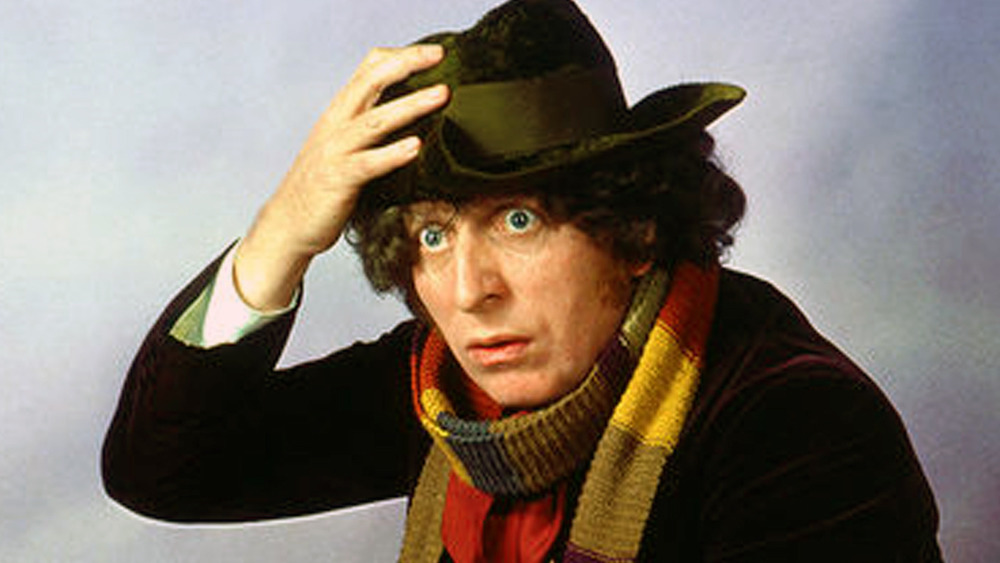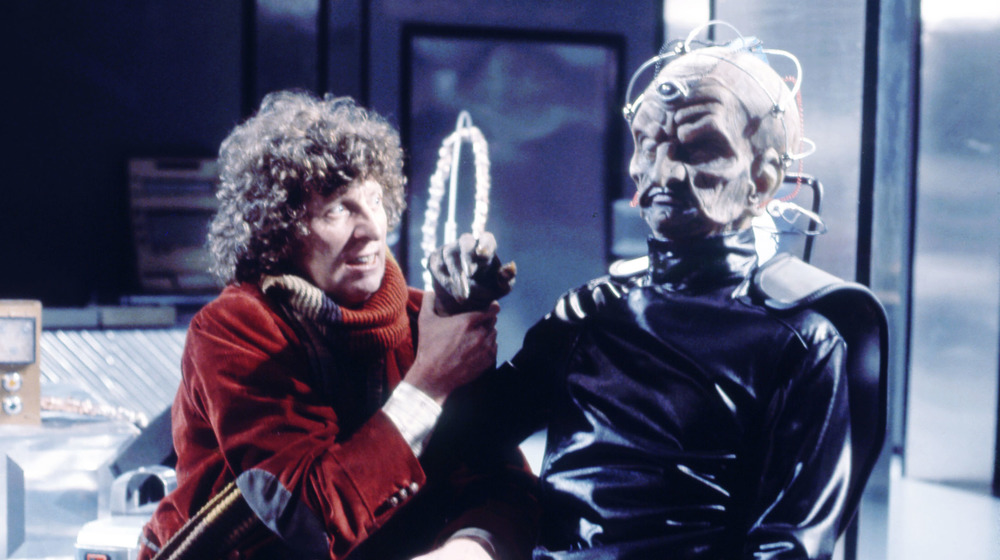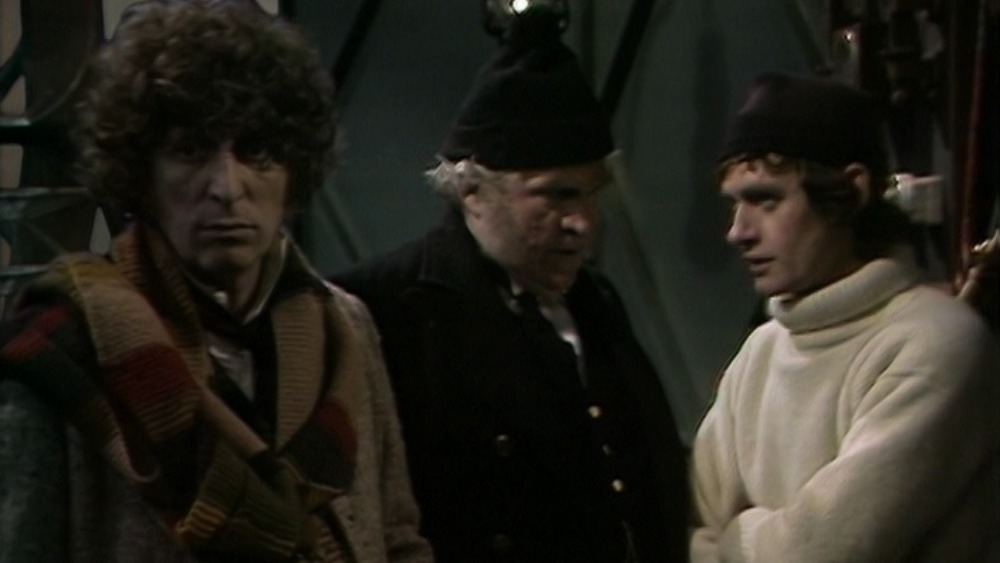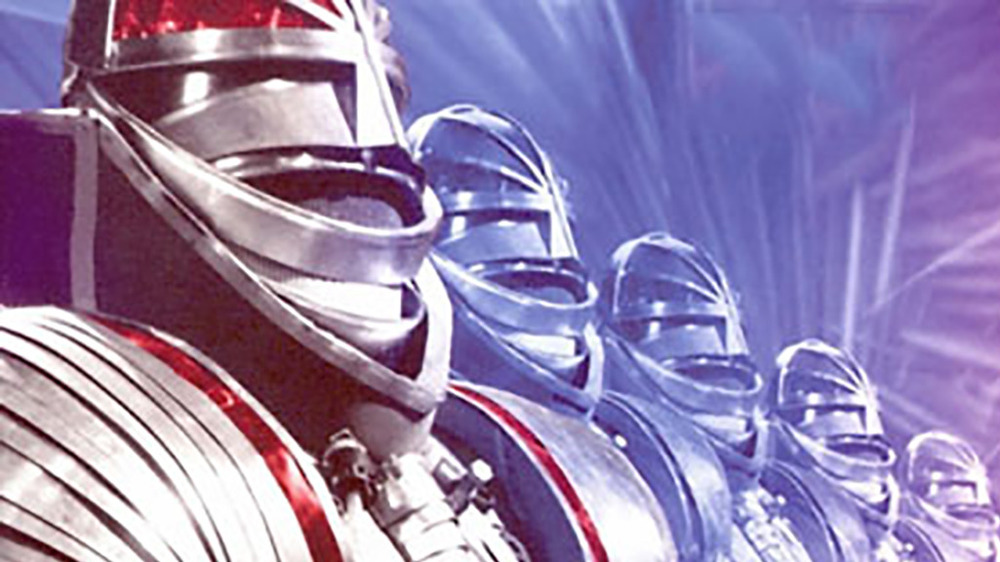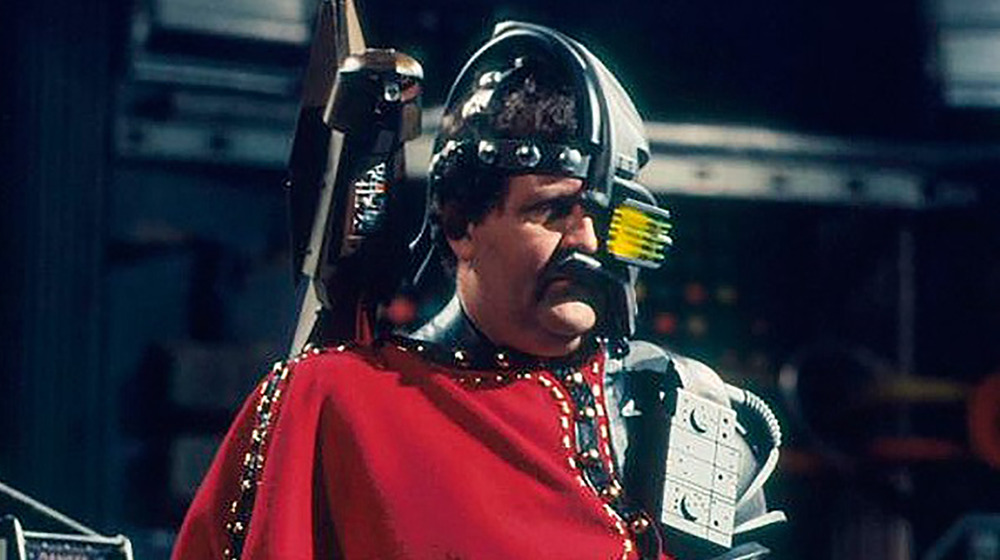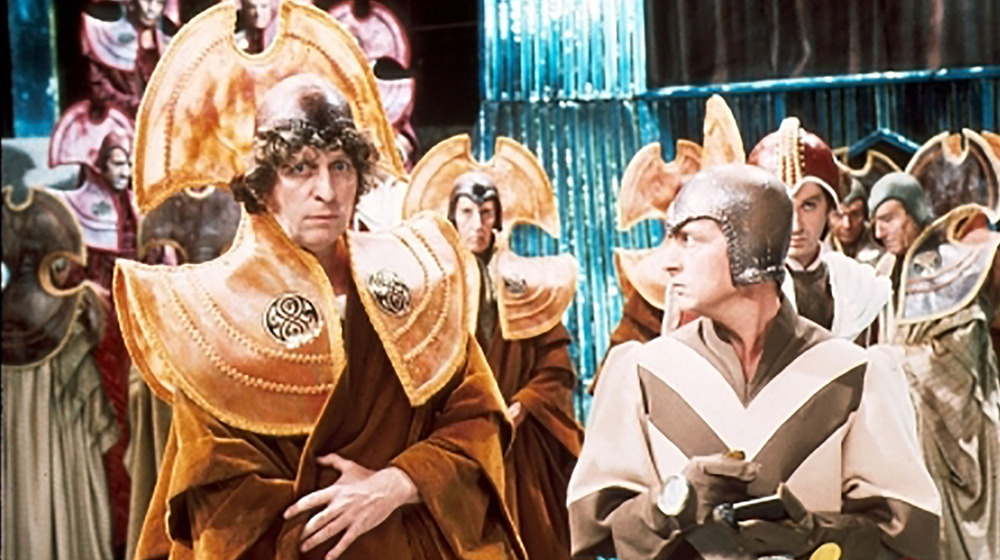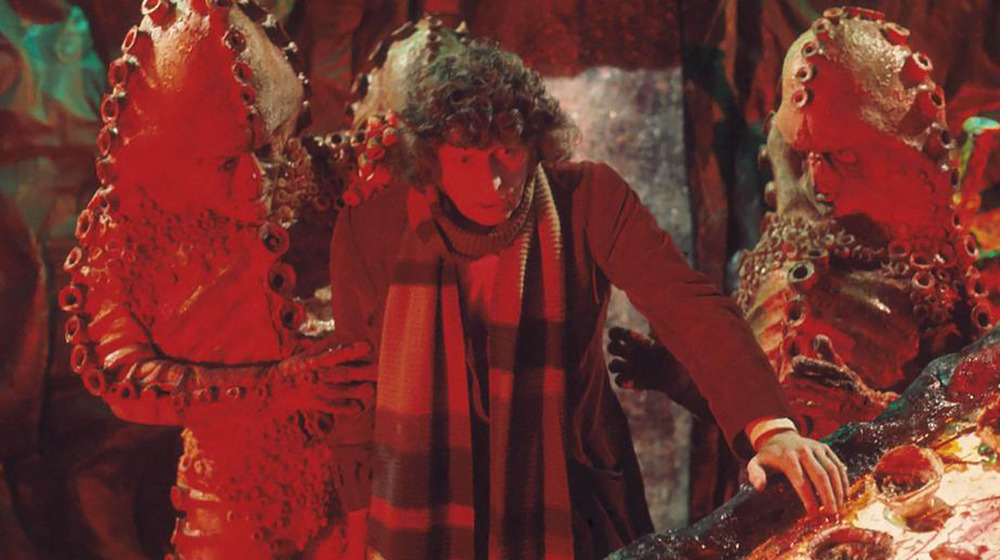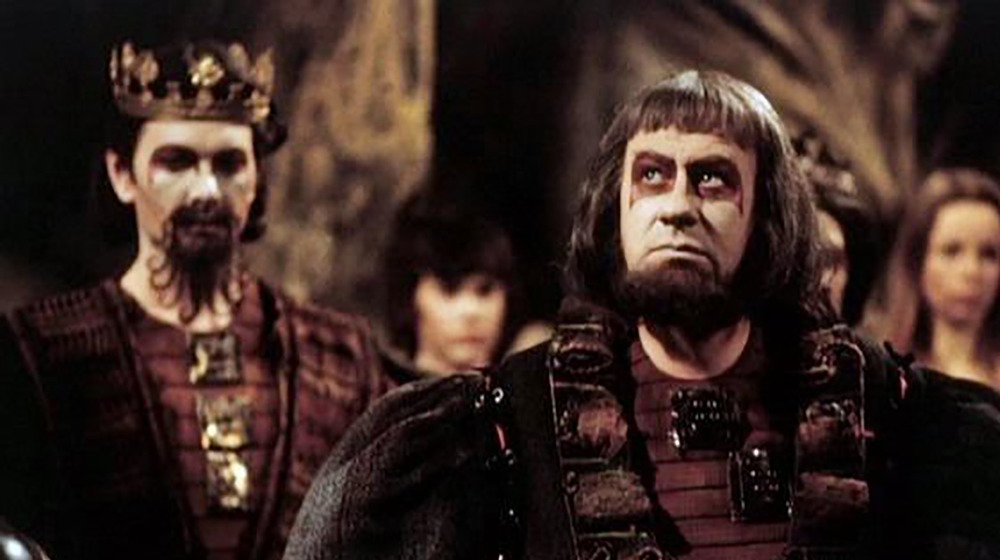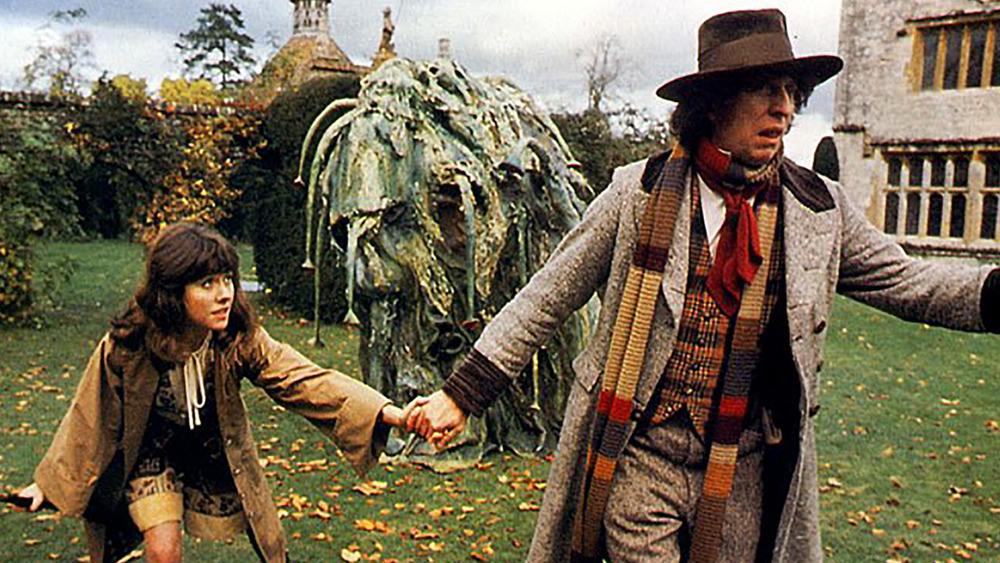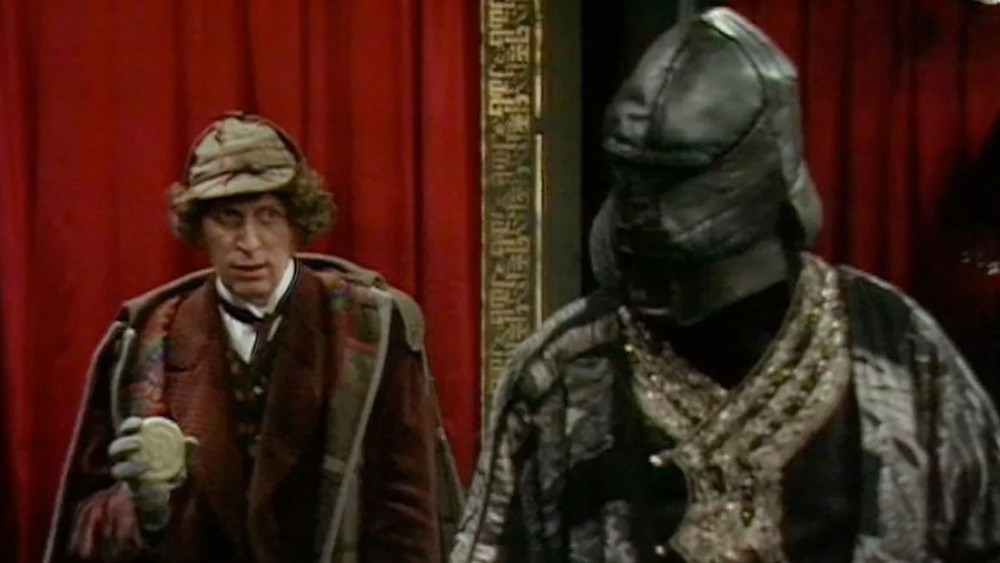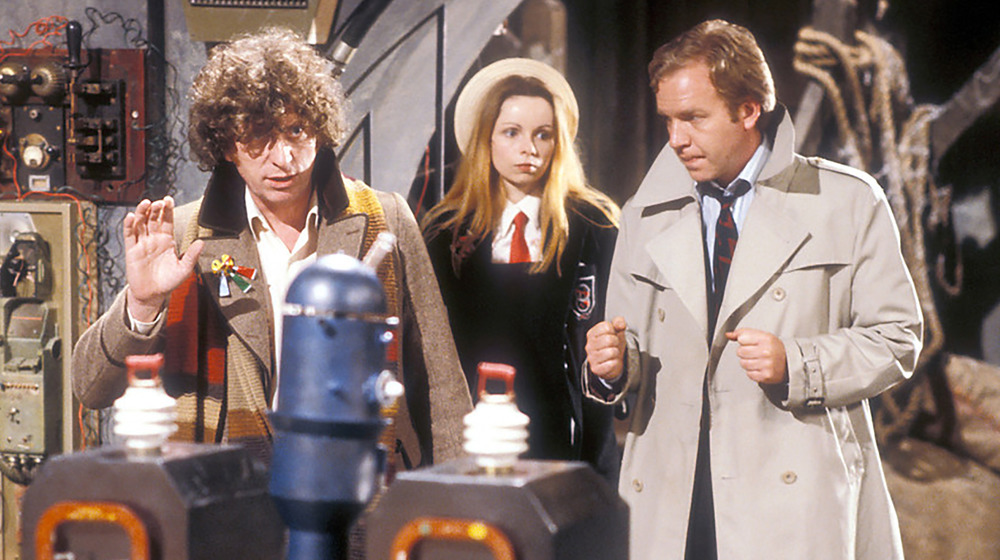The Top Doctor Who Stories Of The Tom Baker Era
Longtime fans of the BBC institution Doctor Who all have their favorite actors who have served as the title character. Yet above them all, Tom Baker, who played the fourth Doctor from 1974 to 1981, seems to occupy a space reserved only for the most revered. It is no wonder: Given how the previous Doctor, played by Jon Pertwee, practically saved the series from cancellation with his action-oriented depiction, it was going to take a big personality to fill his shoes. Baker obliged.
Much of what later actors brought to the role is indebted to Baker's sideways, alien reactions to the most normal of circumstances, and his steadfast confidence when things got crazy. He proved that The Doctor could be funny without jeopardizing a story's suspense. He was, for the era he inhabited, the perfect performer for that role.
During this time, some of the most loved, seminal Doctor Who stories took hold of the imaginations of people worldwide, not just in the U.K., and the face that awkwardly beamed out of them belonged to Tom Baker.
Genesis of the Daleks
Written by Daleks creator Terry Nation, "Genesis of the Daleks" tells the origin story of the murderous robots that have haunted the Time Lords since 1963 and of the wicked paraplegic Davros, creator of the killer machines. Landing on the planet Skaro, The Doctor, companions Sarah Jane Smith (Elisabeth Sladen), and Harry Sullivan (Ian Marter) are dropped into a pivotal point in time. They can stop the extermination of millions of lives over the eons by preventing the Daleks from ever being created.
The Doctor needs to decide how he will achieve this goal before getting himself, Sarah Jane, and Harry killed. Will it be by force or will he somehow manage to reason with Davros, persuading him to back down from his dreams of domination? Unlikely. As played by Michael Wisher, Davros is a pitiless, ruthless individual consumed by hate. In the end, it is up to The Doctor to decide if he has the right to wipe out all of these evil beings. Even if he has this extraordinary ability to skip through time righting wrongs, does that power allow for genocide?
According to the documentary accompanying the serial on DVD, when Nation turned in the story to outgoing producer Barry Letts and script editor Terrance Dicks, they were surprised by how dark the storytelling was. Incoming producer Phillip Hinchcliffe saw it as an opportunity to elevate the series from it's children's TV mode to something more adult and dramatic.
Horror of Fang Rock
Lighthouses can be terrifying, dark, and isolated, and anything can happen in them at a moment's notice. Who will come rescue you in your hour of need? Who indeed!
"Horror of Fang Rock," written by series veteran Terrance Dicks, finds a small group of people stuck on a lighthouse island, interrupting their greedy plan to capitalize on a little insider stock trading. But crashing their luxury yacht onto the island was the least of their troubles, as a body-snatching alien has killed one lighthouse keeper already and is not done yet.
The Doctor and Leela have also arrived, and it now falls upon them to stop the alien, save the shipwrecked people from themselves, and avert further crises.
Ostensibly a horror story of an alien invader stealing human bodies, "Horror of Fang Rock" instead turns out to be a morality tale. Each of the castaways is betrayed by their own vices and greed, even when one among them finally musters the courage to fight back. The clever twist that writer Dicks employs is to bury longtime Who lore into the mix. The body-snatching alien race is none other than the Rutans. They have chosen Earth as a stronghold against their endless war with veteran series baddies the Sontarans. The money-grubbers in the middle of it all have merely been dealt a bad hand by karma.
Atmospheric and creepy, the true "Horror of Fang Rock" is not as much the enemy from without, but the avarice within.
Robot
Written by Terrance Dicks, the bones of the first Tom Baker story, "Robot," were distinctly a "Third Doctor" skeleton. He's still with U.N.I.T. (United Intelligence Taskforce). They're still fighting earthbound baddies for the most part. Without the season's opening Time Lord regeneration attached, the story could have been a Jon Pertwee entry.
Why then is "Robot" a tale worthy of your time? A mad scientist has been detained by a neo-fascist group with the goal to build a murderous robot. However, said robot has a thread of morality within and Sarah Jane has imprinted herself upon it. Being Baker's first appearance as The Doctor, he needed to do the same with the loyal Who fan base as Sarah Jane did with the robot, giving them a reason to accept him. Baker's Doctor is at times manic and lunatic, and at others deadly serious. He merges the stern grandfather, the slightly dotty uncle, and action hero of the previous three incarnations and plays the role much like they were all still inside him.
According to the documentary Doctor Who Review: The Tom Baker Years, not all longtime viewers were swayed. One disgruntled parent wrote, "My little boy did not like the new Doctor; he thought he was too silly." Yet quirks that Baker brought forward became indelible traits of the character: a scatterbrained energy that would immediately snap into focus, a flair for the melodramatic, and a misread of human culture that enabled alien qualities and goofy humor.
The Pirate Planet
According to the BBC, the perpetually unemployed writer Douglas Adams sent a spec script to the venerable institution Doctor Who. The script was so good, they hired him. At the same time, BBC Radio decided to commission the full first series of Adams' own creation, The Hitchhiker's Guide to the Galaxy. Overnight, Adams went from no job to having two.
"The Pirate Planet," written by Adams, exhibits his known absurdities: an unstable cyborg pirate (Bruce Purchase), his quivering and dutiful first mate, and a hollow planet which flies through solar systems, consuming smaller planets, and grinding them down for precious and valuable resources. Along the way, The Doctor excels at being a nuisance to the pirate and his officious minions, all the while attempting to find the puppet master pulling the pirates' strings.
While Doctor Who had always been considered light entertainment, and humor an integral part of it, the script for "The Pirate Planet" introduces overt comedy into the fold for the first time — but just barely. As shown in the documentary included on the "Pirate Planet" DVD, Parrot Fashion, Graeme MacDonald, the BBC's Head of Serials at that time, strenuously objected to Adams' injection of humor. It was only through the intervention of then-script editor Anthony Read and director Pennant Roberts that MacDonald allowed the story to go forward. The story proved very popular, continuing the series' forward momentum, and even MacDonald was forced to admit he was wrong.
The Deadly Assassin
Doctor Who made no secret of its penchant for using known works of fiction as inspiration. "The Deadly Assassin," written by Robert Holmes, used as its launch point the relatively contemporary The Manchurian Candidate by Richard Condon. Intrigue sparks among the Time Lords on Gallifrey when The Doctor psychically predicts that their president will be assassinated. Shockingly, it seems The Doctor will be the one pulling that trigger.
What might interest new viewers is not where "The Deadly Assassin" got its narrative seeds from, but what other famous works of fiction it may have inspired. Realizing the premonition was sent by his longtime nemesis The Master, The Doctor jumps into "The Matrix," a neural network that turns thought into virtual reality. Keep in mind that this serial aired in 1976, 24 years before the influential film from Lana and Lilly Wachowski.
The other thing that people take away from this story is its visceral depictions of violence. In the matrix, The Doctor is hunted by psychotic clowns, shot at from planes, and apparently drowned in one episode's cliffhanger ending. "Clean up TV" campaigner Mary Whitehouse already publicly disapproved of Doctor Who's steadily increasing mature content, but the drowning scene crossed a line for her. She would use the scene as Exhibit "A" for her cause.
While it might well have been inappropriate for the youngest Who viewers, "The Deadly Assassin" remains a fan favorite and is lauded for its suspense and intensity.
Terror of the Zygons
Body-snatching is a familiar trope in the Doctor Who canon. Given the lore of the Time Lords themselves and their numerous regenerations, viewers are comfortable with the idea of a changing physical form that yields to the same benign, even friendly personality. That makes writing a story which subverts such guarantees very enticing. With "Terror of the Zygons," writer Robert Banks Stewart combines the shapeshifters with a story involving Loch Ness, a location already steeped in mystery.
Brigadier Lethbridge-Stewart and U.N.I.T. are seeking answers for the destruction of oil rigs, with eyewitnesses and survivors claiming the legendary Loch Ness Monster must be involved.
Meanwhile, The Doctor's companion Harry Sullivan (Ian Marter) is captured by the Zygons, an alien race that has already infiltrated the Scottish village next to the Loch. The Zygons whisper and hiss, and the resulting menace of unfamiliar vocal and body language from established television friends is chilling. Sarah Jane (Elisabeth Sladen) is attacked by a Zygon disguised as Harry, and it falls upon The Doctor to find the kidnapped humans before the Zygons can enact their final, treacherous plan.
A tense thriller in every respect, down to the icy score provided by composer Geoffrey Burgon and sinister direction from veteran Douglas Camfield, the star remains Ian Marter in his final turn on the series. In a juicy, nasty turn, he conveys both the amiable Harry and the deadly Zygon running around in his form.
State of Decay
A feudal village on a faraway planet is kept in impoverishment under the rule of three alien vampire lords. Once upon a time, the three were unfortunate humans from another world who had the misfortune of crash landing on a planet where vampires dwelled. The Lords intend to bring back The Great One, the vampire whose bite converted them to the undead.
The Lords see the recently arrived Doctor, Romana (Lalla Ward), and their temporary ward Adric (Matthew Waterhouse) as potential sacrifices and feed. The trio have much more going for them than the peasants living in the squalor below, used as little more than livestock.
In "State of Decay," veteran writer Terrance Dicks took on the task of putting the "creep factor" back into Doctor Who after the more comedic Douglas Adams years. The Lords are suitably menacing and their goal of spilling blood for their god is both gothic and horrific.
Yet behind the eerie narrative lies a parable about the UK class system. The rich and privileged literally feed off the poor and keep them in terrible conditions, undermining their will to fight back. Further, the unending lives of the vampires stand as a reflection of royalty whose family lines rule across generations while the working class rises and falls with a continual churn.
While not as frequently cited as other Doctor Who yarns, "State of Decay" remains a trenchant allegory of the era it arrived from.
The Seeds of Doom
A seed pod has been found in Antarctica, containing a plant-like tentacle that "stings" with spores if an animal comes in close proximity with it. The spores will propagate inside and outside of the animal, acting as a parasite until the plant life has consumed it. And by the way, humans are animals, too.
If that wasn't bad enough, a mad millionaire named Harrison Chase (Tony Beckley), who harbors a love of plants and a hatred of human life, has gotten his hands on this murderous Chia Pet. It is up to The Doctor and Sarah Jane to stop him from setting the green beast upon the world without becoming hosts themselves.
"The Seeds of Doom," written by Robert Banks Stewart and broadcast in 1976, takes inspiration from the 1938 John W. Campbell Jr. novella Who Goes There? which was adapted as Howard Hawks' The Thing From Another World (1951) and John Carpenter's The Thing (1982). The Doctor Who serial, however, goes one step beyond by speculating what one man with the financial means and dark hearted intent might do with such a dangerous entity.
For many young children of the era, "The Seeds of Doom" would be their first experience with a story about parasitism and body horror. Scenes of previously healthy humans covered in vines and leaves — except for the faint glimpses of the victims' terrified eyes underneath — transcend the easily dismissed special effects of the day, leaving a chilling impression.
The Talons of Weng-Chiang
Although frequently cited as one of the best Doctor Who stories of all time, "The Talons of Weng-Chiang" has not aged well. The Doctor and companion Leela (Louise Jameson) land in London in the 19th Century. Women are disappearing. A cult, the Tong of the Black Scorpion, who are followers of the god Weng-Chiang, might be the abductors. A celebrated magician named Li H'sen Chang is discovered to be the leader of the Tong, but who is the mysterious living god that he serves?
Written by Robert Holmes, the story puts The Doctor figuratively in the shoes and deerstalker cap of Sherlock Holmes and sets him loose on the streets of Limehouse. Things get personal when Leela, typically an assured hunter herself, is abducted. Will she be the next victim?
Airing in 1977, few Who serials dealt with such mature content as "The Talons of Weng-Chiang." Chang is revealed to be an opium addict, while his master is a time traveler much like The Doctor but hardly as altruistic. The story rightly earns its high reputation as a gripping thriller, but in retrospect, one has to reckon with difficult Asian stereotypes, racist tropes, and the fact that several of the Asian characters in the story are heavily made-up English actors adopting stilted Eastern accents.
"The Talons of Weng-Chiang" is filled with thrills, chills, and suspense, yet negatively dates itself with its often ignorant depictions.
City of Death
Having proven Doctor Who could excel at comedy, writer David Agnew brought the humor in the beloved "City of Death." But actually, David Agnew was a pen name employed by the BBC when necessary. The story was initially called "The Gamble with Time," by writer David Fisher. According to the documentary accompanying the "City of Death" DVD, rewrites were needed, but Fisher was unable to do them as he was in the middle of a divorce. Script Editor Douglas Adams took over the rewrites, making the story broader and more comedic.
In it, the suave Count Scarlioni makes money as a high-stakes gambler and never seems to lose. The Count is actually an interdimensional alien, a counterfeiter dealing in copies of the Mona Lisa, and perhaps a key figure in the dawn of humanity itself. The Doctor stumbles about, looking like an idiot next to the sinister Count, who's played by Julian Glover (Indiana Jones and the Last Crusade). The ruse helps The Doctor infiltrate the Count's plan, but also causes him to find Scarlioni scattered across time — the same being living one concurrent life across human history. Oh, and Scarlioni is actually a green, one-eyed monster.
To add a further comedic stamp on the serial, "City of Death" includes a cameo from Monty Python's Flying Circus member John Cleese, whose request to be billed as "Kim Bread" was shot down by the BBC.
